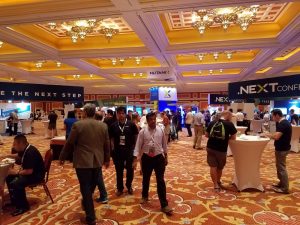 Day 2 of the 2016 Nutanix .NEXT conference at the Wynn in Las Vegas. This morning brought out a couple interesting announcements, as well as the delivery of some features that were announced last year in Miami.
Day 2 of the 2016 Nutanix .NEXT conference at the Wynn in Las Vegas. This morning brought out a couple interesting announcements, as well as the delivery of some features that were announced last year in Miami.
Acropolis Block Services is the most interesting one to me. I expect some fun conversations around this in the months to come. This is an extension to the in-cluster iSCSI services previously released that was primarily targeted to address some specific workloads. The way it works now is that the cluster will get a Data Services IP (DS-IP) which will be a cluster resource. You’ll use that IP when you configure your iSCSI initiators. At any given time, one node will own an iSCSI master role and that IP. When you connect, that iSCSI master will issue an iSCSI redirect to the appropriate online CVM, where the block requests will be serviced. Because the system leverages these redirects, it removes the need for MPIO, and allows online rolling upgrades to function as expected even for these block services. Check out the official page here.
What all this means is that you can use your Nutanix cluster to store data for your bare metal servers, among other use cases. Think shared storage for your Oracle RAC or Windows Server Failover Clusters, as well as any situation where you have an application that you can’t quite virtualize yet for whatever reason. This will be especially useful in situations where you want to replace your storage array, but have servers that aren’t completely depreciated. This allows you to phase in the implementation, making use of your existing infrastructure until you fully transition to your Nutanix cluster.
![]() So… doesn’t this new functionality kind of turn the Nutanix cluster into an iSCSI SAN? How many of these stickers do you see on the laptops of Nutanix employees? In fact, it smells a bit like how Equallogic works.
So… doesn’t this new functionality kind of turn the Nutanix cluster into an iSCSI SAN? How many of these stickers do you see on the laptops of Nutanix employees? In fact, it smells a bit like how Equallogic works.
I think this is a great feature that will open up more opportunities to replace aging infrastructure and move enterprises in the right direction. While I think there are relatively few situations where we should strive to use this feature in permanent configurations, it will make transitions easier. This adds a lot of flexibility in design, and addresses some potential stumbling blocks for potential initiates.
What do you think about this feature?
Categories: Datacenter Servers Storage Tech Soup

1 reply ›